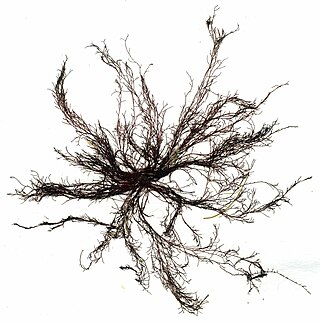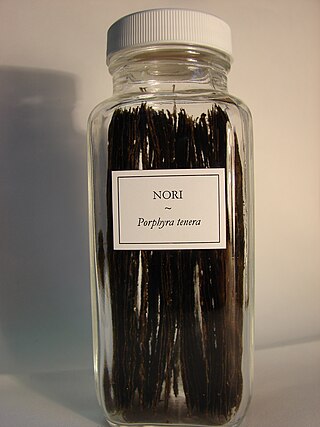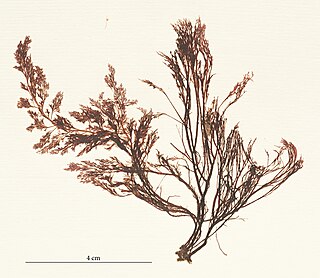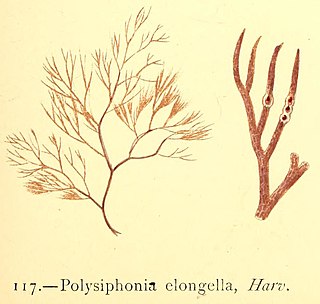
The glaucophytes, also known as glaucocystophytes or glaucocystids, are a small group of unicellular algae found in freshwater and moist terrestrial environments, less common today than they were during the Proterozoic. The stated number of species in the group varies from about 14 to 26. Together with the red algae (Rhodophyta) and the green algae plus land plants, they form the Archaeplastida.

The Oomycetes, or Oomycota, form a distinct phylogenetic lineage of fungus-like eukaryotic microorganisms within the Stramenopiles. They are filamentous and heterotrophic, and can reproduce both sexually and asexually. Sexual reproduction of an oospore is the result of contact between hyphae of male antheridia and female oogonia; these spores can overwinter and are known as resting spores. Asexual reproduction involves the formation of chlamydospores and sporangia, producing motile zoospores. Oomycetes occupy both saprophytic and pathogenic lifestyles, and include some of the most notorious pathogens of plants, causing devastating diseases such as late blight of potato and sudden oak death. One oomycete, the mycoparasite Pythium oligandrum, is used for biocontrol, attacking plant pathogenic fungi. The oomycetes are also often referred to as water molds, although the water-preferring nature which led to that name is not true of most species, which are terrestrial pathogens.

Gracilaria is a genus of red algae (Rhodophyta) notable for its economic importance as an agarophyte, as well as its use as a food for humans and various species of shellfish. Various species in the genus are cultivated among Asia, South America, Africa and Oceania.

Polysiphonia is a genus of filamentous red algae with about 19 species on the coasts of the British Isles and about 200 species worldwide, including Crete in Greece, Antarctica and Greenland. Its members are known by a number of common names. It is in the order Ceramiales and family Rhodomelaceae.

Plocamium is a genus of red algae in the family Plocamiaceae. It contains around 40 species and has a cosmopolitan distribution in temperate seas, although it is most diverse in the southern hemisphere. It is widely distributed in tropical and also warm-temperate and cold-temperate seas, such as northern Europe, the northern Arabian Sea and western Australia. They are also found in the Antarctic regions of Admiralty Bay and Terra Nova Bay.

Pyropia tenera, also known as gim or nori, is a red algal species in the genus Pyropia. The specific name, tenera, means "delicate" and alludes to its small size. It typically grows to lengths between 20 and 50 cm. It is most typically found in the western Pacific Ocean and the Indian Ocean.
Polysiphonia brodiei (Dillwyn) Sprengel, now generally spelled "brodiaei", as it is named after James Brodie is a species of red algae in the Rhodophyta. It grows in tufts up to 36 cm long.

Stylonema alsidii is a species of marine red algae. The type locality is Trieste in Italy, but it has a worldwide distribution.

Polysiphonia elongata is a small red marine algae in the Rhodophyta.

Polysiphonia elongella Harvey in W.J. Hooker is a branched species of marine red algae in the genus in the Polysiphonia in the Rhodophyta.

Polysiphonia stricta is a small red marine alga in the Division Rhodophyta.

Mastocarpus papillatus, sometimes called Turkish washcloth, black tar spot, or grapestone is a species of red algae in the family Phyllophoraceae. It is sometimes confused with the distantly related Turkish towel which is of a similar texture but larger. The specific epithet papillatus is due to the nipple-like projections on the female gametophyte which can give the texture of a terrycloth washcloth found at a Turkish bath.
Pythium porphyrae, is a parasitic species of oomycete in the family Pythiaceae. It is the cause of red rot disease or red wasting disease, also called akagusare (赤ぐされ) in Japanese. The specific epithet porphyrae (πορφυρα) stems from the genus of one of its common hosts, Porphyra, and the purple-red color of the lesions on the thallus of the host. However, many of its hosts have been moved from the genus Porphyra to Pyropia.

Chondracanthus exasperatus, commonly called Turkish towel, is a species of seaweed in the family Gigartinaceae. The specific epithet exasperatus refers to the bumpy texture of the blades. This texture also leads to the common name which evokes the luxurious feel of a towel from a Turkish bath. The rough, papillae-strewn blade surface even makes it difficult to measure the temperature using infrared thermometers.










